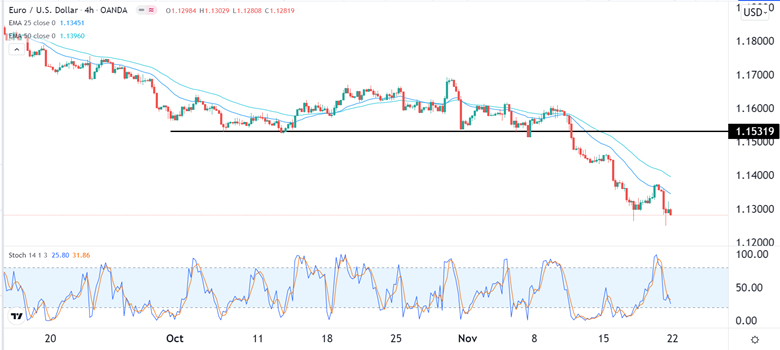Bearish View
Sell the EUR/USD and set a take-profit at 1.1200.
Add a stop-loss at 1.1350.
Timeframe: 1-2 days.
Bullish View
Set a buy-stop at 1.1300 and a take-profit at 1.1400.
Add a stop-loss at 1.1200.
The EUR/USD pair tumbled to the lowest level in more than a year as the US dollar continued its bullish momentum. The pair also crashed after some European countries announced new Covid restrictions as the number of cases rise. It is trading at 1.1280, which is slightly above last week’s low of 1.1250.
Eurozone's New COVID Wave
The Eurozone is experiencing a new wave of the Covid-19 pandemic. In the past few weeks, the number of countries announcing more cases has increased. They include countries like Spain, Netherlands, Germany, and Austria.
Last Friday, Austria announced that it will enforce mandatory vaccinations. Most importantly, the country announced that it will impose a new lockdown in a bid to control the illness. This announcement led to protests during the weekend.
In a statement, a German minister said that the country will be forced to add new restrictions to prevent the spread. He did not clarify whether these restrictions will be national or regional. Similarly, more countries are considering adding these lockdowns.
Therefore, there is a likelihood that the Eurozone’s economy will struggle even as the US does well. Most importantly, there is a likelihood that the European Central Bank will be left behind as other central banks tighten.
Indeed, in a statement last week, Christine Lagarde said that it was unlikely that the ECB will hike interest rates in the coming year. With cases rising, there is also a likelihood that the bank will slow down the pace of quantitative easing tapering. Still, analysts believe that Europe will deal with the new wave better than before because of the rising number of vaccinations.
Meanwhile, recent data from the United States signal that the Federal Reserve will continue tapering and even hike interest rates earlier than expected.
EUR/USD Forecast
On the four-hour chart, we see that the EUR/USD pair has been in a strong bearish trend lately. As part of this sell-off, the pair managed to move below the key support at 1.1530, where it struggled to move below a few times in September and October. The pair’s decline is also being supported by the 25-day and 50-day moving averages while the Stochastic Oscillator has moved from the oversold level.
Therefore, the pair will likely keep falling in the near term as investors price in a divergence between the Fed and the ECB. This could see it drop to 1.1200.


